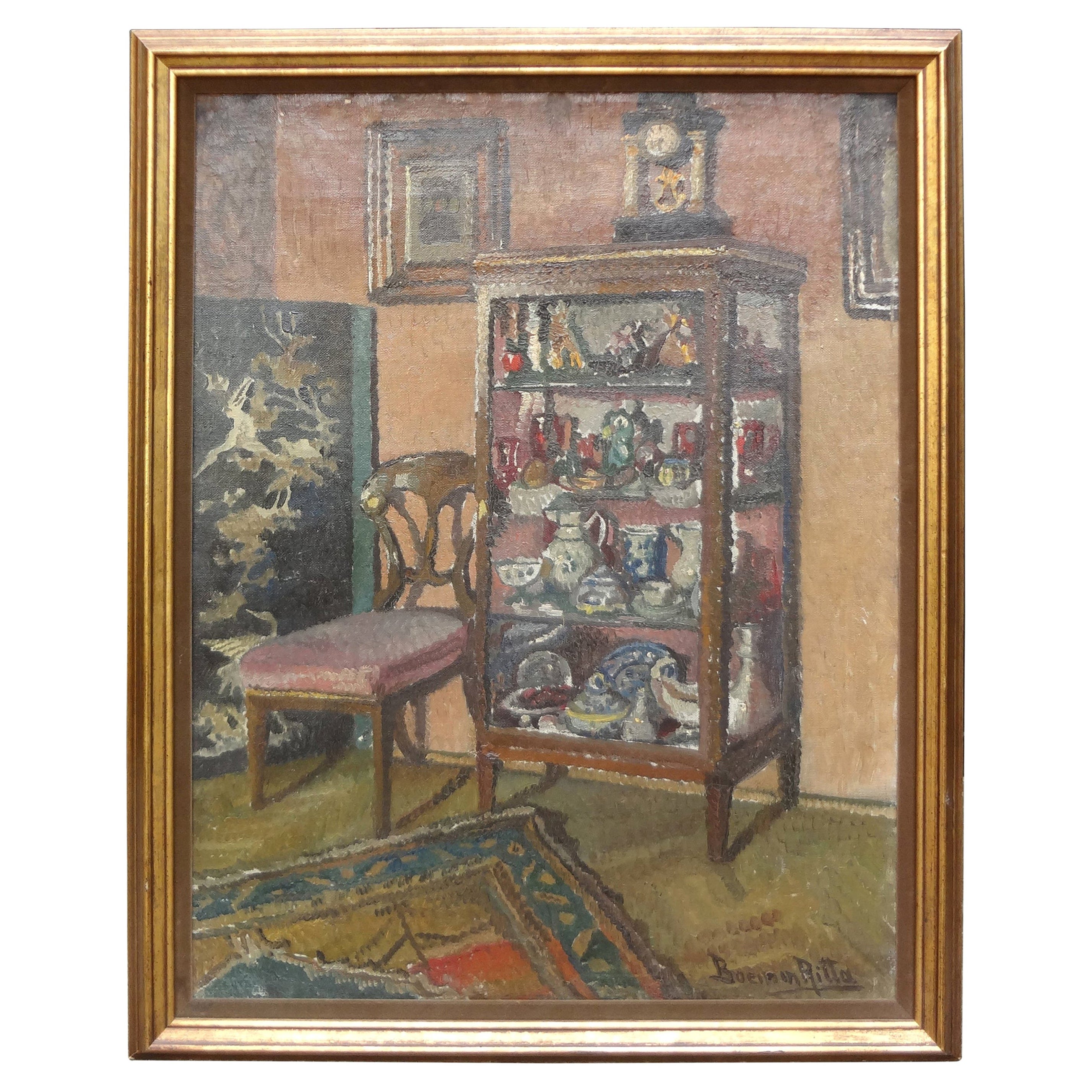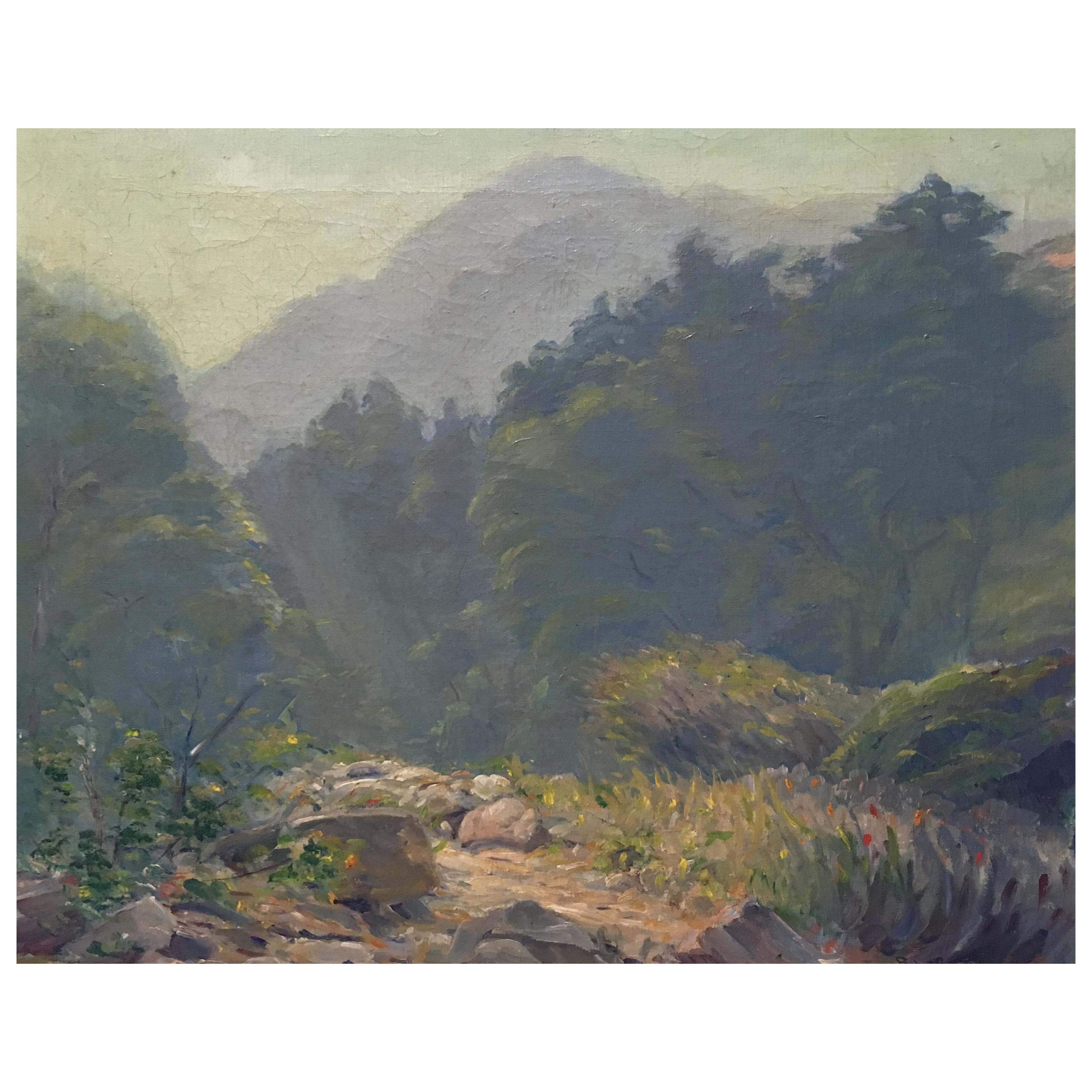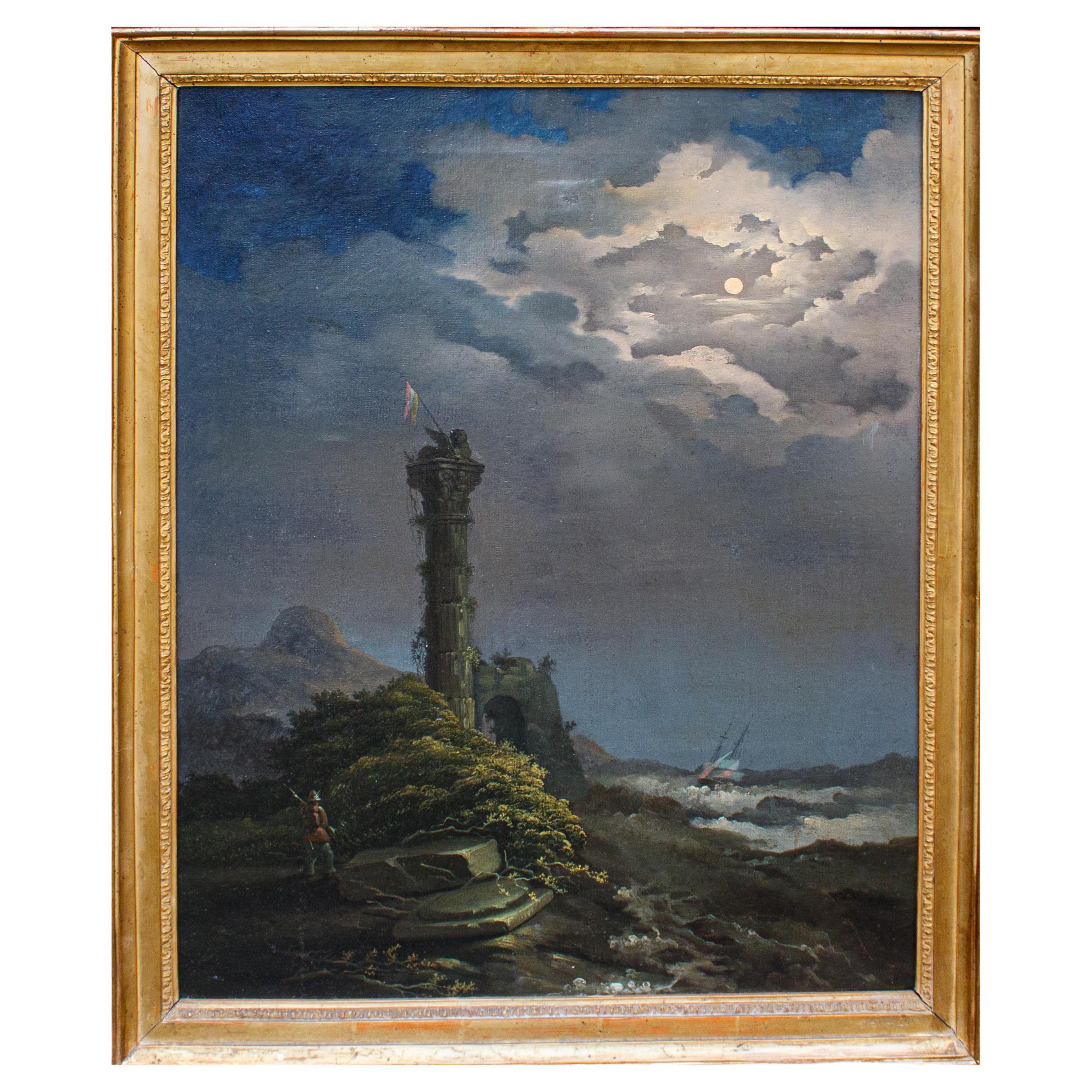Items Similar to 19th Century Pompeian Scene Painting in Oil on Canvas by Gerolamo Graffigna
Want more images or videos?
Request additional images or videos from the seller
1 of 14
19th Century Pompeian Scene Painting in Oil on Canvas by Gerolamo Graffigna
About the Item
Gerolamo Graffigna (Genoa, 1861 - Savona, 1932)
Pompeian scene
Oil on canvas, 80 x 117 cm
Contemporary frame 134 x 99 cm
Signed lower right "G.mo Graffigna, 1888"
The work depicts a typical Pompeian scene, with the foreground occupied by the mother Cornelia who accompanies her two sons, Tiberio and Caio, dressed in white robes and bearing fresh flowers, as a tribute to the divinity they went to worship during the festivity. dedicated, perhaps the Floreali, in honor of the goddess Flora, an ancient Sabine divinity of the Quirinale, who was witnessed in various colored robes, in imitation of the flowers of the fields and gardens, of which the awakening of the whole of nature was celebrated. Alongside the ancient habit of crowning the head with garlands of flowers, mimes were introduced, small comic scenes in which women were also allowed to act: it is said that the spectators asked to undress on the stage. There were numerous temples dedicated to it,
Cornelia, the mother of the Gracchi, was born around 190 BC from Scipio Africano, who definitively defeated Hannibal in the battle of Zama, 202 BC (Second Punic War) and from Emilia. In 175 BC Cornelia married Tiberio Sempronio Gracchus, to whom she bore twelve children. Widowed at the age of 35, she refused a very prestigious wedding with Ptolemy VIII, the future king of Egypt, in order not to fail in her duty as a mother; of the children, however, only Tiberio and Caio ("tribunes of the plebs") and his sister Sempronia, who married Scipione Emiliano (the one who successfully concluded the Third Punic War), reached adulthood. Cornelia, the mother of the Gracchi, is remembered in the anecdote told by Valerio Massimo. It is said that one day Cornelia received a visit from a rich Roman matron, who flaunted and praised the jewels she wore; Cornelia let her speak, then called her children and, turning to the matron, said proudly: "These are my jewels." The choice of such a subject, which ideally brings the viewer back to the classical world, is linked to the passion for antiquity widespread in Europe since the previous century, especially after the discovery of Pompeii and Herculaneum, the two cities that were buried by the eruption of the Vesuvius in 69 AD. The charm of the buried city had a great echo and strong reflections in the artistic production, both Italian and foreign, in particular English and French (Sir Lawrewnce Alma-Tadema, John William Waterhouse, Joseph Franque among others). If at first we focus on the moment of the eruption and on the drama of the end of Pompeii starting from the 1850s, on the impulse of the Neapolitan representatives of this pictorial genre (Domenio Morelli, Camillo Miola, Federico Maldarelli and their followers) a more anecdotal and sentimentalist trend is preferred, defined as “neo-Pompeian”. The representations are inserted in classical architectures such as the baths, the domus or the tabernaee. Often, we witness a production centered on “Pompeian women”, as in this case the re-enactment of one of the best known domina of the Roman world.
The author of the painting is Gerolamo Graffigna, signed in the lower right corner. He trained in the workshop of Nicolò Barabino, active in Genoa and Pietra Ligure, and devoted himself mainly to paintings of genres, religious subjects and landscapes. He often worked as a fresco painter in churches of Ponente Ligure, including San Giacomo the Major in Tovo San Giacomo, San Giovanni Battista in Cervo, where he frescoes the vault of the chapel of the Immaculate Conception, and the church of San Marino di Tours in Toirano. , where he worked between 1890 and 1893, with the fresco of the facade and decorating the main nave and the presbytery, depicting the episodes of the miracles of the Bishop of Tours.
From 1889 he exhibited regularly at the exhibitions of the Promotional Society of Fine Arts in Genoa, making his debut with this painting (those of the years 1890, 1891, 1892 and finally in 1906 followed one another); in 1892 he participated in the Italo-American Exposition in the IV Colombian Centenary and in the same year he also exhibited at the Fiftieth Anniversary Exhibition of Modern Art of the Turin Fine Arts Promotion Society. The participation in the National Fine Arts Exhibition in Milan in 1906 is documented with the painting “Daughter of the generalo Oyama”.
- Dimensions:Height: 52.76 in (134 cm)Width: 38.98 in (99 cm)Depth: 7.09 in (18 cm)
- Materials and Techniques:Canvas,Oiled
- Place of Origin:
- Period:
- Date of Manufacture:1888
- Condition:Wear consistent with age and use.
- Seller Location:Milan, IT
- Reference Number:1stDibs: LU5918226766702

About the Seller
5.0
Vetted Seller
These experienced sellers undergo a comprehensive evaluation by our team of in-house experts.
Established in 2000
1stDibs seller since 2021
25 sales on 1stDibs
Typical response time: 10 hours
More From This SellerView All
- 19th Century Moonlit Landscape Painting Oil on CanvasLocated in Milan, IT19th century Moonlit landscape Measures: Oil on canvas, 67 x 51.5 cm With frame 75 x 59 cm Signed lower left “Luigi Giavazzi” The landscape illuminated by the nocturnal light of the moon that illuminates the sky depicts a collision between natural elements: if on the one hand we find the luxuriant hilly landscape with the rocks covered by shrubs and the grotesque tower with the lion of San Marco...Category
Antique 19th Century Italian Paintings
MaterialsCanvas
- 19th Century Cloister Painting oil on canvas by Achille BattistuzziLocated in Milan, ITAchille Battistuzzi (Trieste 1830 - Barcelona, ??1891) Cloister Oil on canvas, 51x67 cm - with frame 74 x 89 Signed lower right "A. Battistuzzi" Achille Battistuzzi (Trieste 18...Category
Antique 19th Century Italian Paintings
MaterialsCanvas
- 19th Century View of Venice Painting Oil on Canvas by Charles LebayleLocated in Milan, ITCharles Lebayle (Paris 1856 - 1898) View of Campo San Zanipolo in Venice Measures: Oil on canvas, 62 x 36 cm With frame, cm 71 x 45 signed at the bottom right This suggestive Venetian view represents one of the most famous equestrian statues of the Renaissance, the Bartolomeo Colleoni executed by Andrea del Verrocchio, and the imposing church of Santi Giovanni e Paolo (also called San Zanipolo in Venetian dialect) located in Campo dei Santi Giovanni e Paolo also known as Campo San Zanipolo. It is one of the largest fields of Venice, located in the Castello district, on the border with that of Cannaregio, where in addition to the two mentioned monuments there is also the Scuola Grande di San Marco, ancient and precious place that before the dispersion housed paintings such as The miracle of San Marco ( Gallerie dell'accademia), the Discovery of the body of San Marco ( Brera) the theft of the body of San Marco ( Gallerie dell'Accademia) by Tintoretto but also paintings by Gentile and Giovanni Bellini...Category
Antique Late 19th Century Italian Paintings
MaterialsCanvas
- 19th Century The Betrothed Painting in Oil on Panel by Guglielmo NapoliLocated in Milan, ITGuglielmo Napoli (Pavia, 1868 - Genoa, 1945) The betrothed Oil on panel, 46.6 x 68 cm Frame 73 x 81 cm Signed lower left "Gugl . mo Napoli Dipinse" The work in questi...Category
Antique 19th Century Italian Paintings
MaterialsCanvas, Paint
- 18th Century Genre Scene Painting Oil on Canvas Attributed to Paolo MonaldiLocated in Milan, ITPaolo Monaldi (Rome, 1710 - after 1779), attr. Genre scene Oil on canvas, 34 x 25 cm With frame, 36 x 46 cm The canvas describes a moment of rest taken from the rural world: the strings of a lute plucked by an elderly man in the foreground cheer a woman with her child and a passer-by with his mule stopped to listen. The subject is typical of Paolo Monaldi, a painter born in Rome in 1710 and a pupil of the landscape painter Paolo Anesi...Category
Antique 18th Century Italian Paintings
MaterialsCanvas
- 19th Century Portrait of Tiziano and Rembrandt Couple of Paintings Oil on CanvasLocated in Milan, IT19th century Portrait of Tiziano Vecellio and Rembrandt Measures: (2) Oil on canvas, 25 x 18.5 cm Frame 46 x 37 cm The two portraits depicting the artists Tiziano Vecellio and Rembrandt are to be counted among the reproductions of those famous self-portraits made by the two painters throughout their careers. As far as Titian is concerned, the artist creates numerous self-portraits that shoot him in different ages of his life and in different poses from time to time. An example is the one kept in the Prado Museum (Tiziano Vecellio, Self-portrait, 1560, oil on canvas, 86 × 65 cm, Museo del Prado, Madrid), which portrays the now elderly master, as in the present case. The thick white beard reaches almost to the chest, depicted almost in profile, while here the bust is frontal and the face turned three-quarters; his gaze is then turned to the outside of the painting and his expression seems tired and thoughtful. The broad forehead is uncovered and cut by a tight black bonnet from which no hair comes out. A thin white collar separates the face from the rest of the body dressed in an elegant and sober black dress, just like in this portrait. The figure clearly emerges from the background devoid of objects or furnishings, so that nothing distracts our gaze from the image of the famous artist who thus wants to be remembered. Another example is the self-portrait in Berlin (Self-portrait, 1552, 96 x 75 cm, Staatliche Museen, Berlin), which depicts the elderly artist, but decorated with a rich dress and placed in a physical space. Finally, the lost self-portrait in oil on paper, cited by Vasari in his Lives in 1545, keeps a low profile, as evidenced by the rather modest dress...Category
Antique 19th Century Italian Paintings
MaterialsCanvas
You May Also Like
- 19th Century Continental Interior Scene Oil on Canvas Painting by Ritta BoemmLocated in Houston, TX19th century Continental interior scene oil on canvas painting by Ritta Boemm. This charming interior shot depicts a room with a chair, Persian carpet and vitrine with a collection w...Category
Antique 19th Century European Napoleon III Paintings
MaterialsCanvas
- California Oil on Canvas Painting, 19th CenturyLocated in Cypress, CACalifornia oil on canvas landscape painting, "Evening Glow" - Otto Robert Gaensslen (1876-1915; American) Late 19th-early 20th century. Artist Bio: ...Category
Antique Late 19th Century American Paintings
MaterialsCanvas
- 19th-Century Framed Oil Painting on Hardboard Depicting Genre SceneLocated in Opole, PL19th-Century Framed Oil Painting on Hardboard Depicting Genre Scene We present you a small painting from the late 19th century depicting a genre scene. The oil is on hardboard, the ...Category
Antique Late 19th Century European Paintings
MaterialsHardwood, Paint
- 19th Century Oil Painting of Barn Yard SceneLocated in Sheffield, MAThe 19th century oil-on-canvas painting shows a gathering of roosters, hens, chicks and ducks in front of two farm buildings. The black frame in edged in gilt. The painting is wired for hanging. There is an artist's signature. Farm yard scene.Category
Antique Mid-19th Century Unknown Victorian Paintings
MaterialsCanvas, Wood, Paint
- 19th Century Spanish Orientalist Framed Oil on Canvas PaintingLocated in Marbella, ES19th Century Spanish Orientalist Framed Oil on Canvas Painting Measurements with frame: 61.5x72.5x4cm.Category
Antique Mid-19th Century Spanish Paintings
MaterialsCanvas, Wood
- 19th Century French Oil Painting on Canvas of FloralLocated in Houston, TX19th Century French oil painting on canvas of floral. Oil painting on canvas framed with a liner and gilt wooden frame.Category
Antique 19th Century French Modern Paintings
MaterialsCanvas, Wood, Paint, Giltwood
Recently Viewed
View AllMore Ways To Browse
Fresco Modern Painting
Imitation Antique Furniture
Vault Furniture
19th Century Battle Scene
Garden Goddess
Italy Battle Painting
1850s Dress
Genoa Italy Painting
English 19th Egypt
William Let
Italian 19th Century Garden Decoration
French Crown Jewels
Egypt King
Egyptian Two Headed
19th Century Jewel Case
Ancient Egyptian Wall
Sister Jewel
Antique Vault





